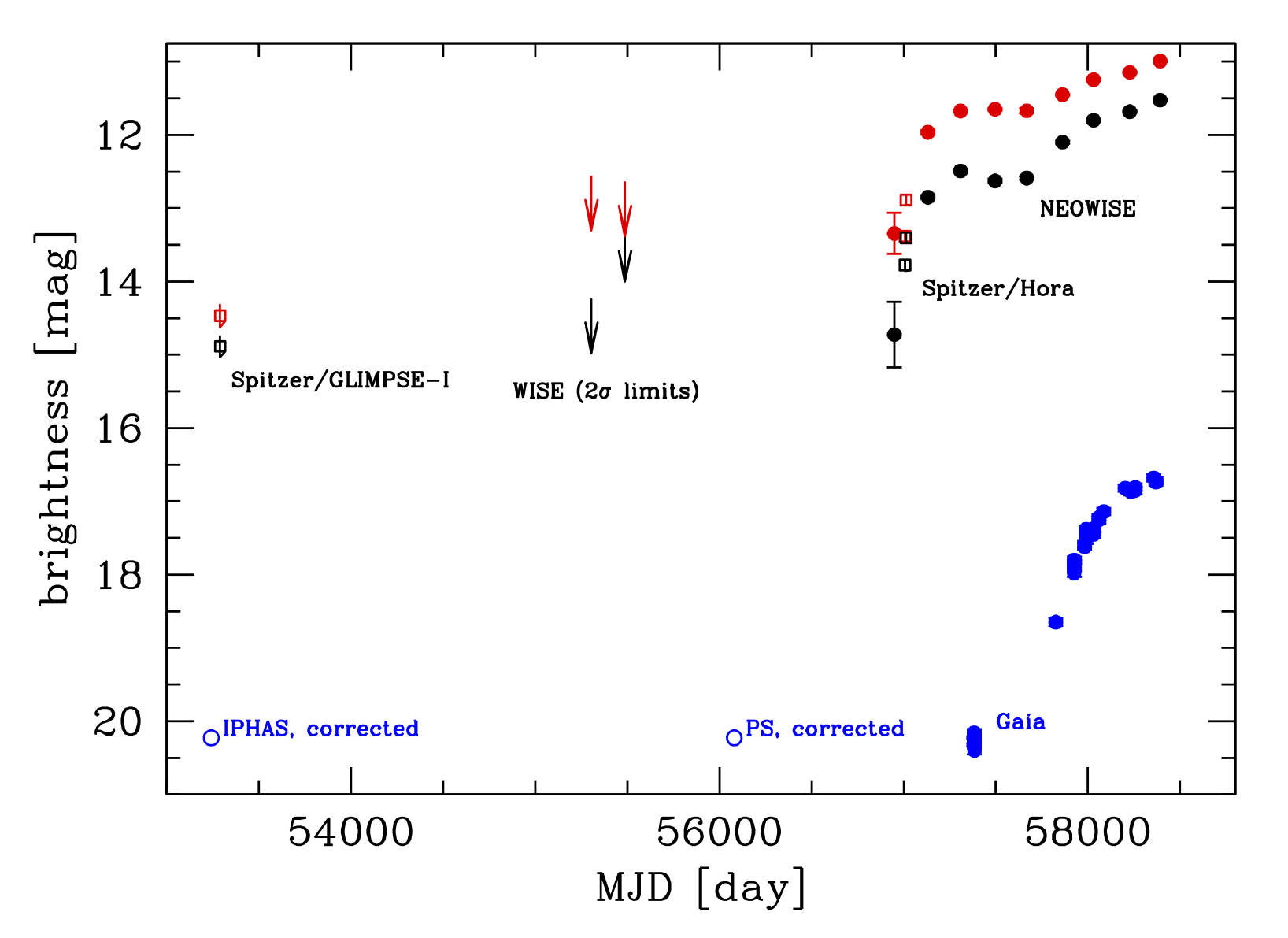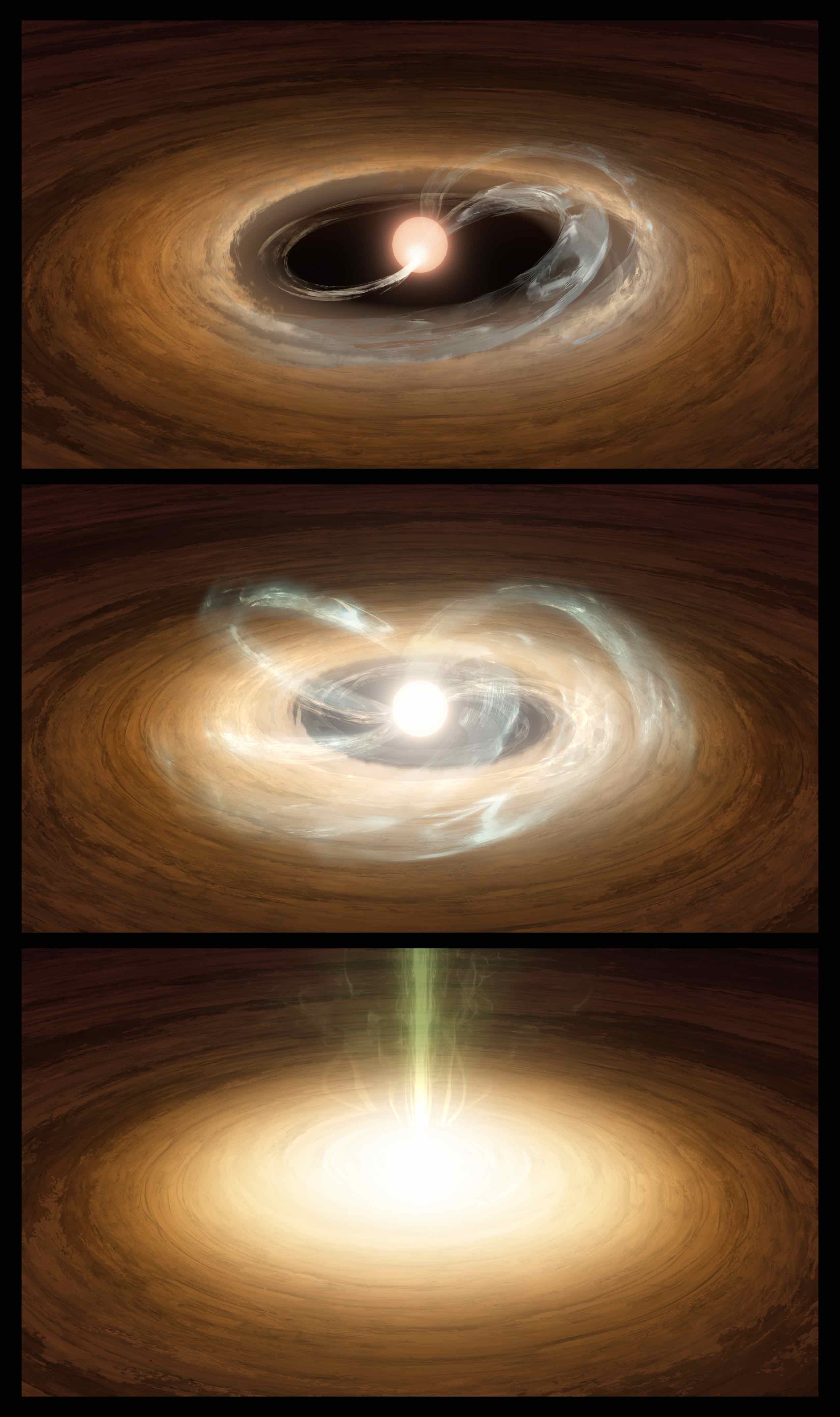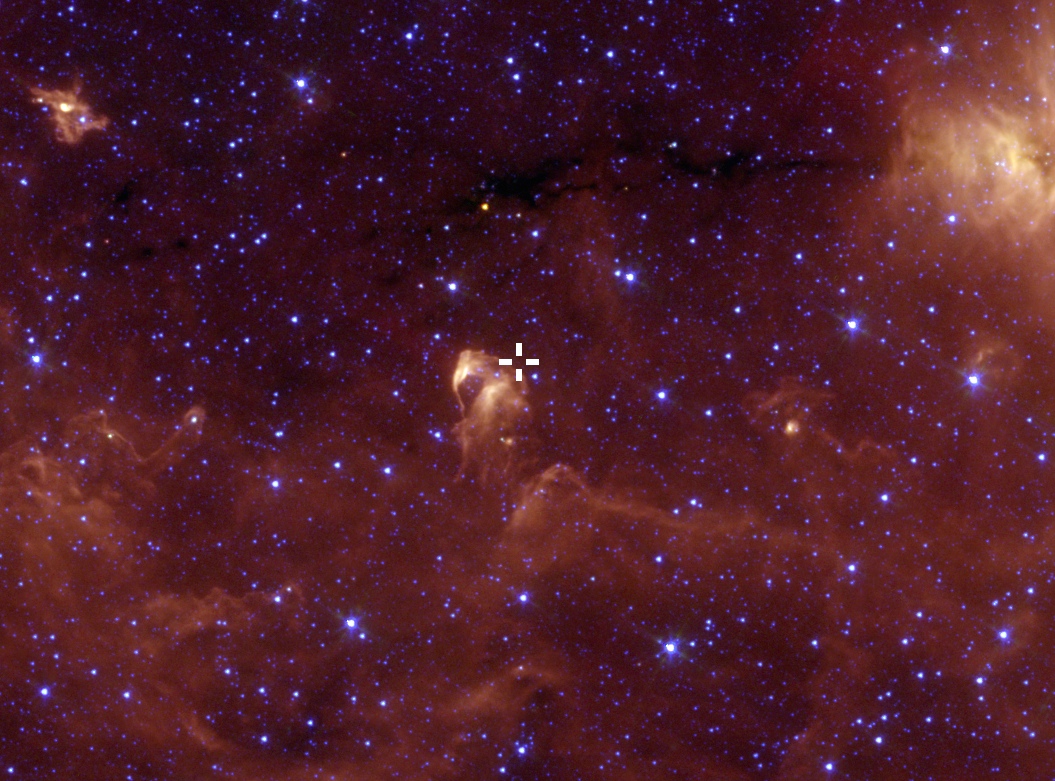IoW_20181218 - Gaia
Image of the Week |
Gaia captures a rare FU ORI outburst |
|
|
|
Figure 1: Lightcurve measured by Gaia (G-band with effective wavelength of 0.673 micron) in blue filled symbols and NEOWISE (3.4 and 4.6 microns) in black and red filled symbols. The horizontal axis denotes time in days [MJD]. Added to the recently obtained photometric data is the previously obtained information on this source by the IPHAS and PanSTARRS surveys in the optical, corrected from the r-band to the G-band, as well as the information obtained from Spitzer in the infrared, plotted as the native 3.6 and 4.5 micron measurements, without correction. This additional information is indicated with open symbols. The downward pointing arrows indicate the epochs of position coverage by the WISE sky survey, in which the source was not detected. Credit: Hillenbrand et al. 2018. |
|
FU Orionis stars are young, near-infant variable stars named after their prototype in the constellation of Orion, displaying an extreme change in magnitude and spectral type. These type of stars are important for star formation theories, and their outbursts are thought to be the main way in which stars acquire their mass, after the initial gravitational collapse and the formation of the "protostar". To better understand star formation and the differences between observations and theories, FU Orionis stars and their outbursts are essential. While these objects are important for this field of study, it still remains a mystery why we do not see very many of them. To date, only about 25 FU Orionis stars are known, while only a dozen were actually observed to undergo an outburst. These outbursts are therefore rare events, much more rare than for example a supernova or even tidal disruption events. Finding a FU Orionis object is thus very special, and finding one that is outbursting is an exceptional opportunity. While Gaia scans the sky (see the scanning illustrated in the video below), it repeatedly observes sources. Over its nominal lifetime of 5 years, Gaia is expected to see each source on average 70 times. Hence, when the brightness of a source rises or falls, it will be visible in the Gaia data. To allow for a timely follow-up of transient events, a significant change in source brightness in the Gaia data can trigger an alert and the information on the source is then shared through the Gaia Photometric Science Alerts webpage allowing scientists to observe the event with other observatories. The paper by Hillenbrand et al. 2018 accepted for publication by ApJ (scheduled to appear in the 20 December issue) describes the discovery of such a FU Orionis object that is undergoing an outburst. This discovery was based on Gaia data which was made public through the Gaia Photometric Science Alerts.
Gaia scanning the sky. Video credit: ESA/Gaia/DPAC. Video acknowledgement: B. Holl (University of Geneva, Switzerland), A. Moitinho & M. Barros (CENTRA – University of Lisbon), on behalf of DPAC.
These alerts are related to the area Gaia is looking at (to predict which sources Gaia will observe, one can use the Gaia Observation Forecast Tool). An overview of the alerts triggered by the Photometric Science Alerts pipeline (residing at one of the DPAC institutes in the UK: the Institute of Astronomy of the University of Cambridge) is given in the below video.
Gaia alerts over time as published by the Gaia Photometric Science Alerts team. Video credit: S. Koposov. When looking closely, one can recognise the scanning law in the pattern of triggered alerts. Also, a gap is visible in the second half of 2015, caused by a verification phase of the alerts system taking place in this period.
On June 23 2017, an alert was issued for Gaia17bpi since a difference of about 2 magnitudes was observed with respect to earlier observations of the source by Gaia. The object was flagged as an outburst of a young stellar object. The source continued to brighten since the alert and is currently at a G magnitude of about 17. Following the Gaia alert, the source was monitored using the Liverpool Telescope. Also the University of Kent's Beacon Observatory performed some additional optical imaging. Apart from following up, Hillenbrand et al. investigated whether the source was detected by other observatories in the past years. It turns out that there were some NEOWISE observations available. The combination of some of the data for Gaia17bpi can be found in Figure 1, which shows the lightcurve of the FU Ori outburst.
“Gaia is making a continuous movie of the sky, perfect for catching explosive events in the act. We are so lucky to have seen this rarest of eruptions at both optical and infrared wavelengths which enables us to uncover the physics at work in the youngest stars", says Simon Hodgkin, member of the Gaia Photometric Science Alerts team.
The observations by Gaia and other observatories are presented in the paper by Hillenbrand et al. These observations show direct evidence for the initial heating out in the disk (infrared lightcurve from NEOWISE+Spitzer), the subsequent heating of the innermost regions close to the star (optical lightcurve from Gaia), the temperature structure of the disk (spectroscopy from Keck and Palomar), the strong outflow, and the youth of the source (distinguishing it from other types of outburst objects such as cataclysmic variables).
Figure 2: Artist's rendition of a FU Orionis outburst in action. This illustration shows a young star undergoing a type of a growth spurt. Top panel: Material from the dusty and gas-rich disk (orange) plus hot gas (blue) mildly flows onto the star, creating a hot spot (bright spot). Middle panel: The outburst begins - the inner disk is heated, more material flows to the star, and the disk creeps inward. Lower panel: The outburst is in full throttle, with the inner disk merging into the star and gas flowing outward (green). Image credit: Caltech/T. Pyle (IPAC)
Interested in further reading?
The location of Gaia 17bpi, which lies in the Sagitta constellation, is indicated in this image taken by NASA’s Spitzer Space Telescope. Image credit: NASA/JPL-Caltech/M. Kuhn (Caltech)
|
|
Credits: ESA/Gaia/DPAC, S. Hodgkin, L. Hillenbrand, S. Koposov, Gaia Photometric Science Alerts Team, Caltech/T. Pyle (IPAC) [Published: 18/11/2018] |
- Removed a total of (16) style text-align:center;
- Removed a total of (15) style text-align:justify;
- Removed a total of (1) style font-style:italic;
- Removed a total of (1) border attribute.
- Removed a total of (1) cellpadding attribute.
- Removed a total of (1) cellspacing attribute.
- Converted a total of (2) youtube to youtube-nocookie.
Image of the Week Archive
- Removed a total of (1) border attribute.
- Removed a total of (1) cellpadding attribute.
- Removed a total of (1) cellspacing attribute.








































 Sign in
Sign in
 Science & Technology
Science & Technology


